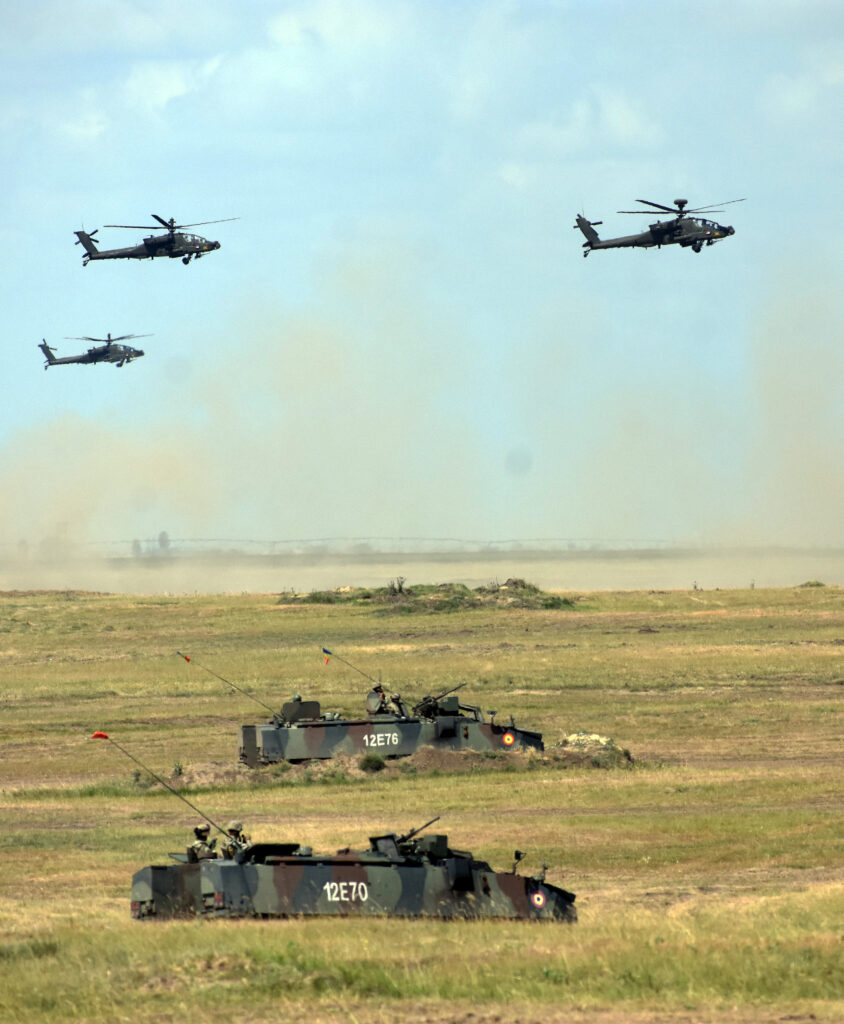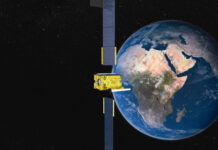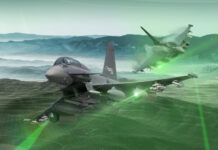NATO is the most successful military alliance in modern history, but it is being put to the test. Three recent conflicts—the Second Nagorno-Karabakh War (2020), the Israel–Hamas conflict (2021), and the ongoing Russia–Ukraine War (2022–) — provide valuable lessons concerning the methods of the next war.

The Second Nagorno-Karabakh War has been called the first war in history to be primarily won by robotic systems, while the Israel–Hamas conflict is sometimes credited with being the first to be won primarily by artificial intelligence (AI). The ongoing Russia–Ukraine War, the largest in Europe since WWII, is a war of vast scale, bloody attrition, and constant innovation. We must use these conflicts to recognise the changes in warfare and reimagine how we fight.
There are many leaders in NATO committed to studying these wars in breadth, depth, and context, but more need to do so. Human will, inspired and guided by determined leadership, is the driving force of victory. The best way to deter war is to be so prepared that any potential adversary will never take the risk of starting one. Facing multiple threats, and with conflict escalating in Ukraine, NATO must understand and anticipate the changing methods of warfare and act in time to shape, contest and deter. Here are seven takeaways that NATO should embrace from these conflicts.
Leadership Matters
The most urgent challenge is to cultivate leaders with the imagination and foresight to envision possibilities beyond existing boundaries. Fostering imagination concerning the changing methods of war and the foresight to act in time, is not an easy task. Leaders can improve their imagination and gain foresight through reading, study, interaction, dialogue, wargaming, and Red Teaming.
The three significant conflicts – the Second Nagorno-Karabakh War (2020), the Israel-Hamas War (2021) and the ongoing Russia-Ukraine War (2022) – have highlighted the harsh reality of using novel and evolving technologies in new ways in war. Leaders at all levels, including soldiers, generals, and policymakers, must comprehend the dynamic changes of these conflicts and adapt in time, or else pay for their ignorance in the blood of their soldiers. It is crucial for NATO and the US to promptly examine these conflicts and explore potential strategies in different situations in order to cultivate visionary and imaginative leaders who can effectively prevent a bigger war in Europe.
Fighting Spirit is Vital
In the three conflicts listed above, there is no better example of the intangible strength of fighting spirit than the military and people of Ukraine in the first weeks and months of the Russian invasion. In late-2021, the idea that Russia would attack Ukraine and begin the deadliest war in Europe since 1945 seemed possible, but not probable. By mid-January 2022, the intelligence view had changed, and the US seemed certain the Russians would attack Ukraine, but NATO and American diplomacy did not deter the Russians.
Just before the invasion, the US Chairman of the Joint Chiefs of Staff, General Mark Milley, told lawmakers that “Kyiv could fall within 72 hours if a full-scale Russian invasion of Ukraine takes place.” When Russia did invade on 24 February 2022, US intelligence agencies, calculating the size and capabilities of the opposing forces, predicted the Russians would capture Kyiv in two or three days. Apparently, the Russians believed the same logic and thought the Ukrainians would greet them with bread, salt, and flowers, traditional Russian gifts for greeting important guests.
Instead, the Ukrainians greeted the invaders with Molotov cocktails, anti-tank guided missiles (ATGMs), and assault rifles. Ukraine’s stout resistance surprised the world. It is difficult to measure an army’s willingness to fight; the courage and determination to adapt, improvise, and overcome is something at which we can only guess until proven in battle. Second only to the Ukrainians’ will to fight is their ability to think and create solutions as they confront the ever-changing methods of warfare.
Fighting back fiercely against the invasion and adapting rapidly in the chaos of the first weeks of battle, the Ukrainians beat the odds. This ongoing conflict demonstrates the value of fighting spirit. If NATO is to deter war, or defend against a resurgent Russia if deterrence fails, it must have a similar fighting spirit to that demonstrated by Ukraine. It is also a striking reminder of the need to mobilise a nation’s resources in time of war. Manpower and the depth of a nation’s ammunition magazine are just two critical aspects to consider. Mobilising the nation to fight seems unheard of in an era of small, professional military forces, but what is happening in Ukraine is a wake-up call. Could NATO mobilise to fight a major conflict in Europe, or more than one conflict at the same time?
Think to Win
NATO’s military and national security leaders have a duty to understand and study the changing methods of war. We count on these leaders to deter war and, if deterrence fails, to fight smart and win. NATO is at an historic turning point. Faced with the need for change, the US Army has transformed its doctrine into a concept known as Multi-domain Operations (MDO), as a spiritual successor to the AirLand Battle doctrine.
This concept describes how the US Army, as part of the joint force (Army, Navy, Air Force, Marines, and Space Force) will counter and defeat near-peer adversaries capable of contesting the US in all domains (air, land, sea, space, and cyberspace) in both competition and armed conflict. Eventually, this may evolve into a joint doctrine called Joint All Domain Operations for the entire US military. NATO has not yet formalised MDO, but as it develops consensus among its 30 member countries, it has adopted a common theme for MDO.
In a 2021 Three Swords magazine article titled ‘Understanding Multi-Domain Operations in NATO’, Lieutenant Colonel Jose Diaz de Leon, US Air Force, described this theme as “the desire by Allies and partner nations to keep up with, and stay ahead of, the challenge imposed by complex future warfare, through harnessing technology.” In his keynote presentation at the NATO Space and Defence Seminar on 14 June 2023, General Philippe Lavigne, NATO Supreme Allied Commander Transformation, said: “MDO is the ability to effectively address complex, multiple threats across the five operational domains of land, sea, air, space and cyberspace, while synchronising the military instrument of power with others.” To do this will require a focused intellectual effort by leaders in all NATO nations. Reacting to threats is not enough; NATO must think now to win later.
Train as you will Fight
After 20 years of counterinsurgency warfare, NATO is relearning how to fight in peer-on-peer combat. Military units do not rise to the level of their leader’s expectations; they fall to the level of their training. The experiences of the three conflicts referenced earlier demonstrate that the battlespace is becoming more transparent, that there are no firm sanctuaries, and anything that is seen by multi-domain sensors will be targeted. Units must learn to fight dispersed and masked, yet connected.
Massing in a more transparent battlespace is impossible without a full spectrum, multi-domain effort to deceive enemy sensors and disrupt enemy targeting. NATO forces must routinely train in this unforgiving and lethal battlespace to gain the level of competence demanded by modern war.
The importance of being prepared to fight on the first day of conflict was demonstrated during the Second Nagorno-Karabakh War, when Azerbaijan struck first against unprepared Armenian positions. Employing newly purchased, unmanned aerial vehicles (UAVs), loitering munitions, and conventional artillery and rockets, the Azeris destroyed the majority of the Armenian air-defence and command-and-control network within the first week of the war.
Armenian air defence, made up of older, Soviet-era systems, could not stop the Azeri UAVs and loitering-munition attacks. Even when the Armenian air-defence systems were operating, Azerbaijan’s aerial weapons penetrated Armenian airspace and knocked out the defenders. In sports, a winning team does the repetitions needed to master its moves. How many iterations will it take to gain mastery at collective warfighting skills?
How many times must a leader plan, prepare, and execute various missions to gain excellence? Every NATO leader must objectively pose this question and plan accordingly. The number of training iterations that leaders and units perform—in constructive, virtual, and live simulation exercises—must reach a level of execution that becomes second nature.

First Strike Advantage
As a defensive alliance, any new crisis in Europe, either from an accidental spill-over from the Russian–Ukraine War, or a deliberate attack to seize the Suwalki Gap, will not be initiated by NATO. As a result, any attacker will be able to strike NATO forces first, and at a time of their choosing. This is a dangerous advantage that requires NATO preparation to prevent. NATO forces in Poland, Lithuania, Latvia, Estonia, Romania and other NATO countries are stationed at known positions and in largely unprotected facilities.
Today, various sensors can detect almost everything in the battlespace, and long-range precision fires and drones can capitalise on these capabilities to destroy high-value targets (HVT).
The first-strike advantage is the ability of an attacker to paralyse an enemy in the first hours and days of a war. A surprise first strike that destroys the most critical targets, if executed with overwhelming force, can be decisive. Azerbaijan’s armed forces achieved this in the first week of the Second Nagorno-Karabakh War. The Russians did not maximise their first-strike advantage when they invaded Ukraine.
On 10 March 2022, Russian Defence Ministry spokesperson Igor Konashenkov said Russia hit 2,911 Ukrainian military facilities in the first two weeks of the invasion. Even if this number were accurate, it did not break Ukrainian defences, nor their will to fight. Despite hundreds of Russian artillery, missile, and air strikes in the war’s opening stages, Russian long-range precision-fires were inadequate for the scale and depth of the battlespace. Russia hit key targets, such as Ukraine’s internet service and communications capabilities, but in two weeks, the internet was back in operation thanks to the Starlink satellite constellation.
The Russians failed to eliminate other high-value targets (HVTs), such as capturing or killing President Zelensky and destroying key Ukrainian Government facilities and headquarters. If a resurgent Russia ever conducted a first strike against NATO, they would have learned from the 2022 invasion that they must go ‘all in’ to make the first strike a decisive blow. China, a vigilant observer of this conflict, has also learned this lesson.
Loitering Munitions and Unmanned Aerial Vehicles
Of all the latest battlefield technologies, loitering munitions (LMs) and unmanned aerial vehicles (UAVs) have had the most dramatic impact in the battlespace. LMs provide the most cost-effective means to attack forces on the other side of the hill or deep behind enemy lines. Capable of loitering over an area, searching for targets, and then striking, they are an effective and cost-effective means by which to conduct precision strikes. In any military engagement, timing is vital, and LMs deliver a ‘loiter, sense and strike’ ability that can reduce targeting time from minutes to seconds.
Unlike traditional aircraft, most LMs require little or no runway; most launch from rails or can take off vertically. Some LMs, such as the IAI Harop, launch from truck-mounted launchers, much like a multiple rocket launcher. The Harop can loiter over a target area for up to 9 hours, and carries a 16 kg high-explosive fragmentation (HE-FRAG) warhead. If the Harop cannot identify a suitable target, it shifts to a subsequent priority. If no target is found, it can return to a designated landing point on its own for retrieval and reuse.
There are a wide variety of LMs, from short-range versions such as the American-made Switchblade, to the longer-range Russian Lancet, which has had significant success against Ukrainian armoured vehicles in the summer of 2023. Because of their low cost compared to the price of their targets, LMs are a cost-effective means of delivering persistent, precision strikes. It appears intuitive that every mortar platoon, reconnaissance, and manoeuvre organisation will have LMs, and artillery units will be equipped with LM batteries and longer-range armed UAVs.
This does not mean the tank is dead, as it provides the primary platform for offensive manoeuvre, something drones do not. Tanks, however, will only survive and win if they adapt to the new battlespace. Those militaries that recognise this, and prepare, will gain a tremendous tactical and strategic advantage.

Artificial Intelligence
Technological convergence, in the synergy with miniaturisation, improvements in computing power, robotics, and sensors, is altering the way wars are fought. The introduction of AI is speeding up this paradigm shift. Our AI today is still ’narrow’ and simple, but it enables a wide array of smart, autonomous weapons that swim, drive, and fly throughout the battlespace. Robotics and AI are clearly on the verge of ushering in a period of hybrid human–machine intelligent systems warfare. AI can intelligently sort through large amounts of data to discover optimal targeting parameters much faster than any human.
A noteworthy recent example of AI in combat operations occurred during Operation Guardian of the Walls, the name used by the Israel Defense Forces (IDF) for the 2021 Israel–Hamas War. This war lasted only 11 days but showed the possibilities of future conflicts. The IDF called this the “first artificial intelligence war,” as AI was a key element in their success. Hamas fighters were hiding among the Gazan populace and Israel’s dilemma was to separate combatants from non-combatants in a dense, urban battlespace.
Israeli sensors collected data on their enemies from all sources, centralised this information into a multi-domain sensor database, and accessed it in real-time to generate multi-domain targeting information. Sensors input data continuously and in real-time to update a common operational picture that provided the IDF with a transparent view of their opponents. The IDF also used AI-enabled drone swarms for sensing and striking. The AI generated a super-fast kill chain that enabled the IDF to eliminate enemy fighters and destroy numerous Hamas rocket launchers while minimising civilian casualties within the city of Gaza.
According to Avi Kalo, in a 9 June 2021 Frost and Sullivan report, during Operation Guardian of the Walls, the IDF’s ability to create a “seamless exchange of technology, comprehensive data management, extensive defence digitalisation, and a new Concept of Operations (CONOPS) called ‘Intelligence-as-a-Service’ have also been acknowledged as key to IDF’s successful operations.” AI-powered applications streamlined and analysed a vast amount of data from multiple sources. With this exchange of data, the IDF destroyed their opponent’s rocket production sites, command facilities, key tunnel networks, and ammunition dumps.
A vital lesson from this conflict is that digitally-driven intelligence led to a successful combat outcome. Speeding up the ability to sort, prioritise, recognise patterns, and act on this accumulated information in seconds, rather than hours, makes AI an essential tool of modern warfare. As we connect more military systems in AI-enabled networks where weapons systems transmit and share information, AI will sort through thousands of data points, correlating their significance, recognising the patterns, and providing commanders with actionable courses of action. The military that uses AI to synchronise multi-domain kinetic and non-kinetic effects at machine speeds will gain a significant advantage over those who do not. This is the essence of war in the 21st century.
Looking Ahead
We live in a time of exponential change. Technology is transforming everything, especially the methods of war. Christian Brose, the best-selling author of the book “Kill Chain: Defending America in the Future of High-Tech Warfare”, emphasised this transformation in his testimony to the Congressional Armed Services Committee on 9 February 2023: “In the recent Nagorno-Karabakh conflict, in the continued fighting in the Middle East, and in the ongoing war in Ukraine, we are seeing how low-cost, robotic vehicles, AI-enabled loitering munitions, digital targeting systems, cyber-weapons, persistent communications and surveillance satellites, and other advanced capabilities – especially when paired with large volumes of more traditional weapons – are transforming the modern battlefield.”
The nature of war is a violent clash of interests between opposing wills. Technology and tactics change the methods of war, but not its nature. Many citizens of NATO countries are unaware of the rapid changes in warfare. Military leaders, policy decision-makers, and those in the defence industry must be cognisant of this shift. With a major war raging in Europe, and the potential for that war to escalate into a greater conflict, we must all pay attention. In late June 2022, the British Army’s Chief of the General Staff, General Sir Patrick Sanders, called this time “our 1937 moment,” drawing a comparison to the years leading up to the gathering storm of World War II. It seems the winds of war are howling once again. Are we ready for the coming storm? Will we use the time we have wisely before the gale hammers us?
John Antal











